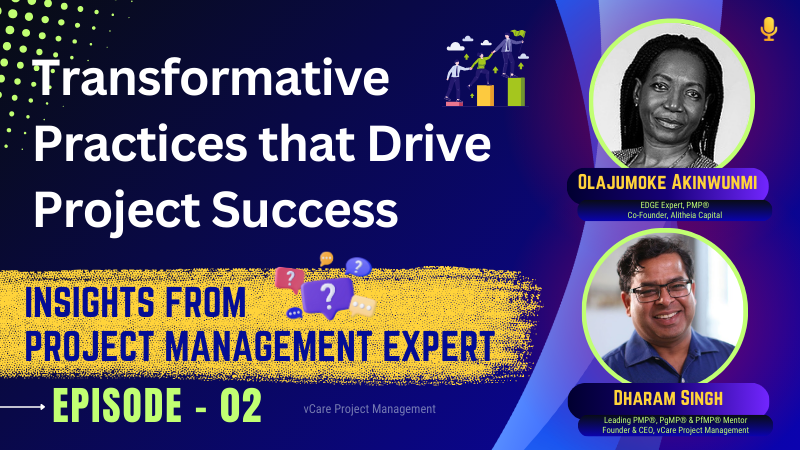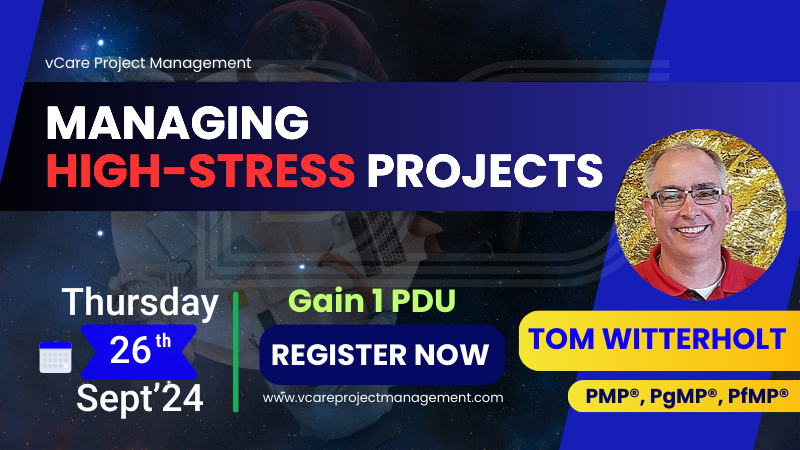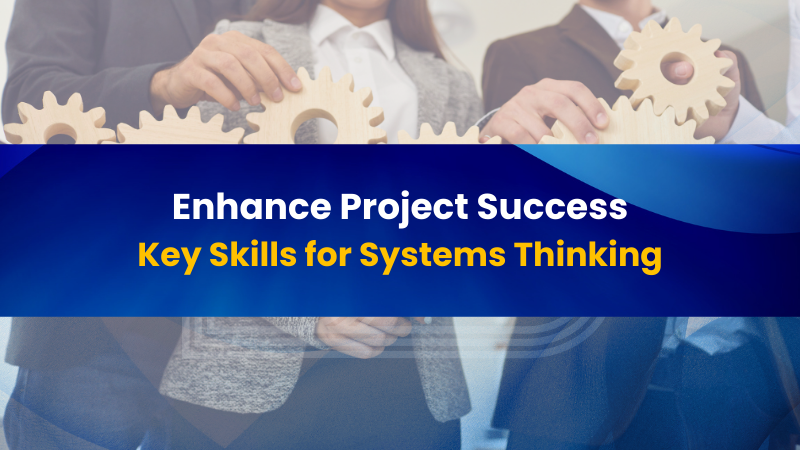
by DharamCW | Apr 3, 2025 | Professional Development Webinars, Project-Program-Portfolio Management Knowledge
🎯 Project success doesn’t come from flashy tools—it comes from purpose, clarity, and people.
In Episode 2 of the Innovative Project Management Practices series, I had the privilege of speaking with Olajumoke Akinwunmi, EDGE Expert & PMP®, about the real strategies that drive project excellence.
💬 We explored what truly transforms project delivery—not just emerging tech or trends, but:
🔹 Early stakeholder engagement
🔹 Clear communication and agile-inspired transparency
🔹 Meaningful team morale boosters
🔹 Smart but thoughtful tech adoption (yes, drones included!)
🔹 Negotiation strategies that build trust, not walls
This episode is a masterclass in grounded leadership, and Olajumoke’s insights are a must-listen for anyone managing complex projects or diverse teams.
📢 Listen Now & Share Your Thoughts:
🎧 Episode 1: Why PMP After 30 Years? 🔗 https://youtu.be/EIoOTElDZGU
🎧 Episode 2: Transformative Practices That Drive Project Success 🔗 https://youtu.be/3rzulUioix4
– Book an obligation-free consultation session on Project management Career, training, and certifications: http://talktodharam.com
– Discover training offers and certification discounts: https://bit.ly/3jWVepD
– Stay updated with our Q&A series and certification success stories by subscribing to the vCare Project Management YouTube channel at https://bit.ly/2YF0wJl
– Follow my podcasts and interviews with Project Management Experts on YouTube at https://bit.ly/2NDY8wd
Let me know your favorite takeaway in the comments!👇
#ProjectManagement #Leadership #StakeholderEngagement #TeamSuccess #AgileLeadership #TechnologyInProjects #PMP #DharamSingh #VCareSuccess #ProjectDelivery #WomenInLeadership #OlajumokeAkinwunmi

by DharamCW | Sep 25, 2024 | Leadership in Project Management, Project-Program-Portfolio Management Knowledge
Understanding what makes a project successful is crucial before starting any new venture. As a leading expert in project management, I’ve tried to identify four key success criteria that can transform your projects from ordinary to extraordinary:
1. On-Time Delivery: Completing projects within the scheduled timeline is paramount. It not only satisfies clients but also builds your reputation for reliability.
2. Budget Compliance: Staying within budget showcases your ability to manage resources efficiently, which is critical for financial success.
3. Achievement of Objectives: Meeting all outlined project objectives is a significant milestone that proves your team’s capability and effectiveness.
4. Positive Feedback: Positive feedback from stakeholders and clients clearly indicates a project’s overall success and impact.
Focusing on these elements can ensure your projects are not just completed but celebrated. As a leading PMP, PgMP, and PfMP trainer mentor, I’ve guided thousands of professionals to clear their PMI certifications. Ready to elevate your project management skills? Let’s connect!
🚀 Elevate Your Project Management Career:
– Register for my upcoming PMI Certification Success Story Webinars: https://bit.ly/4aVhrd6 / https://bit.ly/3QeVhKF
– Book an obligation-free consultation session on Project management Career, training, and certifications: http://talktodharam.com
– Discover training offers and certification discounts: https://bit.ly/3jWVepD
– Stay updated with our Q&A series and certification success stories by subscribing to the vCare Project Management YouTube channel at https://bit.ly/2YF0wJl
– Follow my podcasts and interviews with Project Management Experts on YouTube at https://bit.ly/2NDY8wd
#ProjectManagement #SuccessCriteria #ProjectSuccess #ProjectDelivery #PositiveFeedback #BudgetManagement #TimeManagement #ObjectiveAchievement #StakeholderFeedback #ClientSatisfaction #ProjectPlanning #ProjectGoals #AskDharam #DharamSingh #VCareProjectManagement

by DharamCW | Sep 6, 2024 | Professional Development Webinars
Managing High-Stress Projects | Tom Witterholt | vCare PgMP & PfMP Success Story
Join vCare Project Management for an exclusive webinar featuring Tom Witterholt, a highly accomplished Senior Program Manager with over 34 years of experience in the aerospace and defense sectors from Albuquerque, New Mexico, United States. As the keynote speaker, Tom will share his extensive expertise in managing high-stress projects.
Discussion Topics include but are not limited to,
+ Developing Strategic Thinking: Essential Skills and Learning Paths for Leaders
+ Transforming Underperformance: Leadership Techniques for Transforming Low-Performing Team Members
+ The Strategic Role in Organizational Change: How Strategy Drives Transformation
+ Navigating New Leadership Roles: Strategies for Success in Unfamiliar Territories
+ Interpreting Key Performance Indicators: Understanding and Addressing Misaligned Metrics
Attendees will earn 1 PDU and receive special discount codes for upcoming PMP®, PgMP®, and PfMP® programs. Don’t miss this chance to learn from an industry expert and take your project management skills to the next level.
🔗 Reserve your spot now: https://bit.ly/4fFJTTn
Session Date: Thursday, 26th September 2024
Session Time: 08:30 AM – 09:30 AM (HST) / 10:30 AM – 11:30 AM (AKDT) / 11:30 AM – 12:30 PM (PDT) / 12:30 PM – 01:30 PM (MDT) / 01:30 PM – 02:30 PM (CDT) / 02:30 PM – 03:30 PM (EDT) / 07:30 PM – 08:30 PM (BST) / 08:30 PM – 09:30 PM (CEST) / 09:30 PM – 10:30 PM (AST)
🚀 Elevate Your Project Management Career:
– Book an obligation-free consultation session on Project Management Career, training, and certifications: http://talktodharam.com
– Discover training offers and certification discounts: https://bit.ly/3jWVepD
– Stay updated with our Q&A series and certification success stories by subscribing to the vCare Project Management YouTube channel at https://bit.ly/2YF0wJl
– Follow my podcasts and interviews with Project Management Experts on YouTube at https://bit.ly/2NDY8wd
#HighStressProjects #ProjectManagement #FreeWebinar #PgMP #PfMP #PMI #LeadershipDevelopment #StrategicThinking #TransformationalLeadership #OrganizationalChange #PerformanceImprovement #LeadershipStrategies #ProgramManagement #DefenseIndustry #AerospaceSector #TeamManagement #StrategicLeadership #MetricsAnalysis #LeadershipSuccess #ChangeManagement #LeadershipExcellence #ProjectSuccess #ProjectLeadership #ProjectPlanning #ProjectDelivery #ProjectPortfolio #StressManagement #CrisisManagement #RiskManagement #PgMPCourse #PgMPTraining #PfMPCertification #PfMPCourse #AskDharam #DharamSingh #VcareProjectManagement

by DharamCW | Aug 28, 2024 | Leadership in Project Management, Project Management, Project-Program-Portfolio Management Knowledge
Enhance Project Success: Key Skills for Systems Thinking
As a project manager, you play a crucial role in the success of a project. A project is a system of interdependent and interacting domains of activity. Systems thinking entails a holistic view of how project parts interact with each other and external systems. Systems are constantly changing, requiring your consistent attention to internal and external conditions. Your responsiveness to system interactions allows your project teams to leverage positive outcomes.
The following skills support a systems view of the project:
– Empathy with the business areas
– Critical thinking with a big-picture focus
– Challenging assumptions and mental models
– Seeking external review and advice
– Use of integrated methods, artifacts, and practices so there is a common understanding of project work, deliverables, and outcomes
– Use of modeling and scenarios to envision how system dynamics may interact and react
– Proactive management of the integration to help achieve business outcomes

Enhance project success with key systems thinking skills—holistic project management in action.
By honing these skills, project teams can enhance collaboration, adaptability, and, ultimately, project success. Remember, these skills are not just beneficial; they are essential for your professional growth and the success of your projects.
🚀 Elevate Your Project Management Career:
– Register for my upcoming PMI Certification Success Story Webinars: https://bit.ly/3Lpjifb / https://bit.ly/4fJdX0c
– Book an obligation-free consultation session on Project management Career, training, and certifications: http://talktodharam.com
– Discover training offers and certification discounts: https://bit.ly/3jWVepD
– Stay updated with our Q&A series and certification success stories by subscribing to the vCare Project Management YouTube channel at https://bit.ly/2YF0wJl
– Follow my podcasts and interviews with Project Management Experts on YouTube at https://bit.ly/2NDY8wd
#SystemsThinking #ProjectManagement #SkillsDevelopment #PMBOK #PMBOK7 #PMP #Empathy #Innovation #Agile #Waterfall #ProjectLeadership #HolisticProjectManagement #CriticalThinking #PMPCertification #PMPExam #PMPTraining #BusinessAnalysis #ChangeManagement #ProjectDelivery #ProjectSuccess #ProjectTeams #SystemsDynamics #BusinessOutcomes #HybridProjectManagement #AskDharam #DharamSingh #VCareProjectManagement

by DharamCW | Aug 23, 2024 | Professional Development Webinars










Join us for an insightful webinar hosted by vCare Project Management, featuring Sarah Wright, PMP, PgMP, a Senior Technical Project Manager at Specialized Bicycle Components based in Morgan Hill, California, USA. In this webinar, Sarah will cover essential topics for senior project, program, and portfolio management professionals.
Session discussion topics include the following:
– Strategies for Maintaining Team Morale and Productivity During High-Pressure Projects
– Pivoting Project Management Strategies to Enhance Team Well-being
– Leveraging Resource Management Tools for Project Success
– Measuring the Impact of Resource Allocation on Project Outcomes and Team Satisfaction
– Integrating Agile Principles into Resource Management Practices
– Proactively Identifying and Addressing Root Causes of Stress in Project Teams
By attending, you’ll gain insights from Sarah’s experiences and earn 1 Professional Development Unit (PDU) and a special discount code for upcoming PMP, PgMP, and PfMP programs. Take advantage of this opportunity to enhance your skills and save on future programs.
🔗 Reserve your spot now: https://bit.ly/4fJdX0c
Session Date: Thursday, 12th September 2024
Session Time: 10:00 AM – 11:00 AM (AKDT) / 11:00 AM – 12:00 PM (PDT) / 12:00 PM – 01:00 PM (MDT) / 01:00 PM – 02:00 PM (CDT) / 02:00 PM – 03:00 PM (EDT) / 03:00 PM – 04:00 PM (BRT) / 07:00 PM – 08:00 PM (BST) / 08:00 PM – 09:00 PM (CEST) / 09:00 PM – 10:00 PM (AST) / 10:00 PM – 11:00 PM (GST)